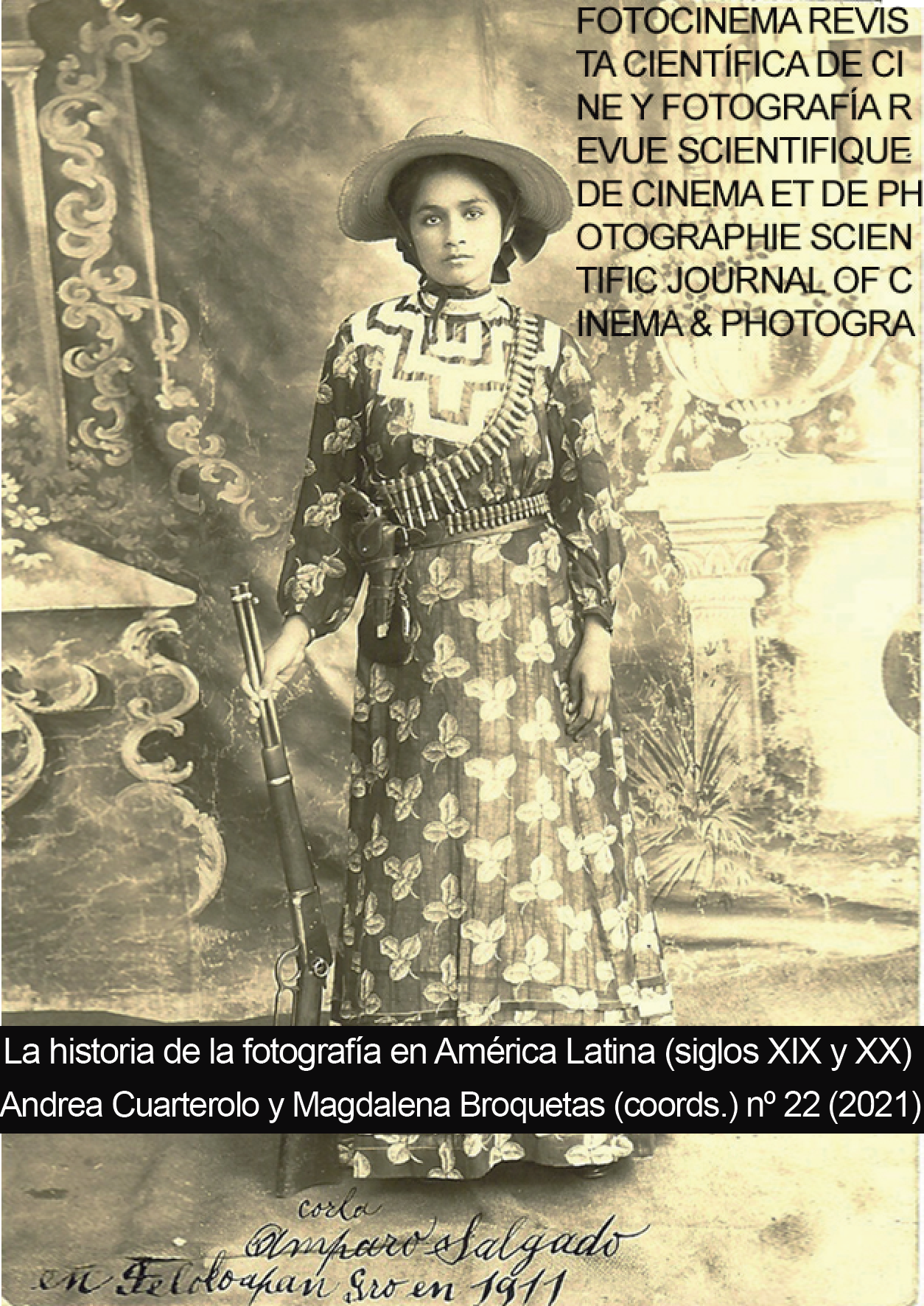War Photography: Díaz & Spencer’s coverage of the War of the Pacific (1879-1883)
DOI:
https://doi.org/10.24310/Fotocinema.2021.vi22.11650Keywords:
War Photography, Pacific War, 1879- 1883, Chile, Díaz & SpencerAbstract
In the study of 19th-century Latin American photography, the photographic capture of war and military operations has implicitly been equated with the eye of national states, understanding that photographers would want to show a positive portrayal of the military forces. However, war photography as a language of state power was not the point of departure. In most of the earlier examples of war photography, it was private photographers who first ventured into military conflicts almost as soon as the new visual technology was made available. They saw war as both an important historical event and a commercial opportunity. Experiencing with a technology that forced them to produce images of war stripped of battle action while trying to capitalize on the diverse interests in these conflicts, most photographers offered a rendering of war of ambiguous political meanings. In this essay, I argue that the photographs of the War of the Pacific taken by the studio Díaz & Spencer are one of the first examples of the successful use of war photography for nation-building purposes, that is, as national propaganda. Photographers had the challenge to create impressive, apologetic and heroic captures of the military forces, and Díaz & Spencer succeeded in creating a visual narrative congruent with Chilean official discourses, consolidating, rather than challenging, the Chilean state view of the war. Equally important, this allignment of political views was accomplished on account of Díaz and Spencer’s initiative—not that of Chilean state officials.
Downloads
Metrics
Publication Facts
Reviewer profiles N/A
Author statements
Indexed in
-
—
- Academic society
- N/A
- Publisher
- Universidad de Málaga
References
Andermann, J. (2007). The Optic of the State: Visuality and Power in Argentina and Brazil. Pittsburgh: University of Pittsburgh Press.
Arellano González, J. (2015). El pueblo de ‘filibusteros’ y la ‘raza de malvados’: discursos nacionalistas chilenos y peruanos durante la Guerra del Pacífico (1879-1884). Diálogo Andino, (48), 71-83.
Babilonia, R. (2006). Memoria de una invasión: La fotografía y la guerra del pacífico. Pozo de Letras, 4(4), 43-53.
Beckman, E. (2009). The creolization of imperial reason. Chilean state racism in the war of the Pacific. Journal of Latin American Cultural Studies, 18(1), 73-90.
Bertrand Dorléac, L. (2014). “Tournant”. In L. B. Dorléac (Ed.), Les désastres de la guerre, 1800-2014 (pp. 16–19). Lens, Paris: Somogy, Musée du Louvre-Lens.
Cederlöf. O. (1967). The Battle Painting as a Historical Source. An Inquiry into Its Principles. Revue Internationale d'Histoire Militaire, (119), 119-144.
Cid, G. (2011). Arte, guerra e imaginario nacional: la Guerra del Pacífico en la pintura de historia chilena, 1879-1912. In C. Donoso & G. Serrano (Eds.), Chile y la Guerra del Pacífico. Santiago: Universidad Andrés Bello, Centro de Estudios Bicentenario.
Figueroa Garavagno, M. (2011). Trazando paisajes, imaginando la nación. La Guerra del Pacífico y la Pacificación de la Araucanía en perspectiva comparada. Apuntes de investigación del CECYP, año XIV, (19), 133-152.
Keller, U. (2001). The Ultimate Spectacle: A Visual History of the Crimean War. Australia, England: Gordon and Breach.
McEvoy, C. (2011). Guerreros civilizadores. Política, sociedad y cultura en Chile durante la Guerra del Pacífico. Santiago, Chile: Ediciones Universidad Diego Portales.
McEvoy, C. (2012). Civilización, Masculinidad y Superioridad Racial: Una aproximación al discurso republicano chileno durante la guerra del Pacífico 1879-1884). Revista de Sociología e Política, 20(42), 73-92.
Mirzoeff, N. (2011). The right to look: a counterhistory of visuality. Durham: Duke University Press.
Rodríguez Villegas, H. (2001). Fotógrafos en Chile durante el siglo XIX. Santiago: Centro Nacional del Patrimonio Fotográfico.
Rosales, J. A. (1984). Mi Campaña al Perú, 1879-1881. Concepción: Editorial de la Universidad de Concepción.
Published
How to Cite
Issue
Section
License
All contents published in Fotocinema Revista científica de cine y fotografía are protected under the Creative Commons Attribution-NonCommercial-ShareAlike 4.0 International (CC BY-NC-SA 4.0) license. All about this license is available in the following link: <http://creativecommons.org/licenses/by-nc-sa/4.0>
Users can copy, use, redistribute, share and exhibit publicly as long as:
- The original source and authorship of the material are cited (Journal, Publisher and URL of the work).
- It is not used for comercial purposes.
- The existence of the license and its especifications are mentioned.
There are two sets of authors’ rights: moral and property rights. Moral rights are perpetual prerogatives, unrenounceable, not-transferable, unalienable, imprescriptible and inembargable. According to authors’ rights legislation, Fotocinema. Revista científica de cine y fotografía recognizes and respects authors moral rights, as well as the ownership of property rights, which will be transferred to University of Malaga in open access. The property rights are referred to the benefits that are gained by the use or the dissemination of works. Fotocinema. Revista científica de cine y fotografía is published in an open access form and it is exclusively licenced by any means for doing or authorising distribution, dissemination, reproduction, , adaptation, translation or arrangement of works.
Authors are responsable for obtaining the necessary permission to use copyrighted images.














13.png)



